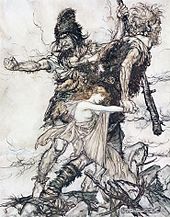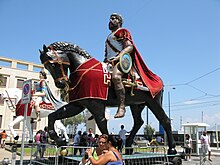
Back Reus Afrikaans Home granizo AN عملاق (تراث شعبي) Arabic Волат Byelorussian Волат BE-X-OLD Великан Bulgarian দৈত্য (পুরাণ) Bengali/Bangla Ramz Breton Gegant (mitologia) Catalan Наьрт CE
This article may need to be rewritten to comply with Wikipedia's quality standards. (August 2019) |


In folklore, giants (from Ancient Greek: gigas, cognate giga-) are beings of humanoid appearance, but are at times prodigious in size and strength or bear an otherwise notable appearance. The word giant is first attested in 1297 from Robert of Gloucester's chronicle.[1] It is derived from the Gigantes (Greek: Γίγαντες[2]) of Greek mythology.
Fairy tales such as Jack the Giant Killer have formed the modern perception of giants as dimwitted and violent ogres, sometimes said to eat humans, while other giants tend to eat livestock. In more recent portrayals, like those of Jonathan Swift and Roald Dahl, some giants are both intelligent and friendly.
- ^ Robert, of Gloucester; Wright, William Aldis (1887). The metrical chronicle of Robert of Gloucester. University of California Libraries. London : Printed for H.M. Stationery off., by Eyre and Spottiswoode. p. 25.
- ^ γίγαντες, Georg Autenrieth, A Homeric Dictionary, on Perseus Digital Library
© MMXXIII Rich X Search. We shall prevail. All rights reserved. Rich X Search